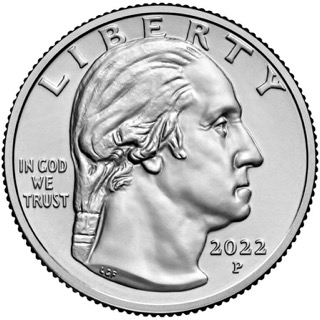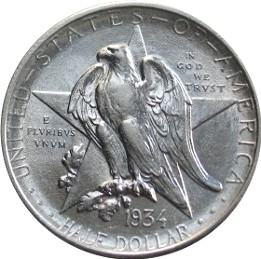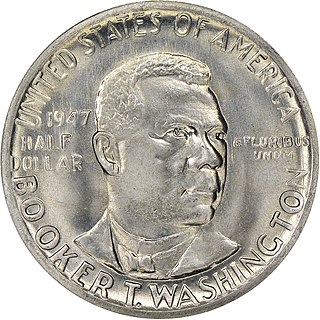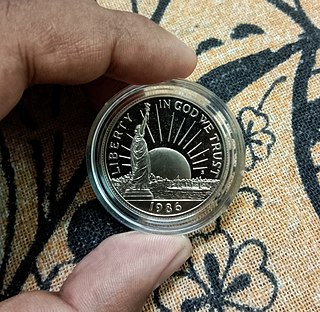
The quarter, formally known as the quarter dollar, is a denomination of currency in the United States valued at 25 cents, representing one-quarter of a dollar. Adorning its obverse is the profile of George Washington, while its reverse design has undergone frequent changes since 1998. Since its initial production in 1796, the quarter dollar has held a significant place in American numismatics, with consistent production since 1831.
The United States Mint has minted numerous commemorative coins to commemorate persons, places, events, and institutions since 1848. Many of these coins are not intended for general circulation, but are still legal tender. The mint also produces commemorative medals, which are similar to coins but do not have a face value, and therefore are not legal tender.

The Franklin half dollar is a coin that was struck by the United States Mint from 1948 to 1963. The fifty-cent piece pictures Founding Father Benjamin Franklin on the obverse and the Liberty Bell on the reverse. A small eagle was placed to the right of the bell to fulfill the legal requirement that half dollars depict the figure of an eagle. Produced in 90 percent silver with a reeded edge, the coin was struck at the Philadelphia, Denver, and San Francisco mints.

The Eisenhower Commemorative silver dollar is a United States commemorative coin minted in 1990 to celebrate the 100th Anniversary of the birth of General/President Dwight D. Eisenhower. This coin is not to be confused with the Eisenhower dollar or the Eisenhower Presidential dollar which were regular issue American coins.
The coins of the Australian dollar were introduced on 14 February 1966, although they did not at that time include the one-dollar or two-dollar coins. The dollar was equivalent in value to 10 shillings in the former currency.

The Washington quarter is the present quarter dollar or 25-cent piece issued by the United States Mint. The coin was first struck in 1932; the original version was designed by sculptor John Flanagan.

The Texas Centennial half dollar commemorative coin was minted to honor the Centennial of Texas's independence from Mexico. Early in the administration of President Franklin Delano Roosevelt, on June 15, 1933, Congress passed an act to authorize the coinage of silver half dollars "in commemoration of the one hundredth anniversary in 1936 of the independence of Texas, and of the noble and heroic sacrifices of her pioneers, whose revered memory has been an inspiration to her sons and daughters during the past century." This was the first of over two dozen commemorative bills that would become reality during Roosevelt's tenure. The legislation provided that "no more than one and a half million pieces" be created on behalf of the American Legion Texas Centennial Committee, located in Austin in that state.

The Lafayette dollar was a silver coin issued as part of the United States' participation in the Paris World's Fair of 1900. Depicting Gilbert du Motier, Marquis de Lafayette with George Washington, and designed by Chief Engraver Charles E. Barber, it was the only U.S. silver dollar commemorative prior to 1983, and the first U.S. coin to depict American citizens.

The Booker T. Washington Memorial half dollar was designed by Isaac Scott Hathaway and minted in silver between 1946 and 1951. The obverse depicts Booker T. Washington. The reverse shows the cabin in which Washington was born, now the Booker T. Washington National Monument, and the Hall of Fame for Great Americans, in which Washington is honored. The description on the reverse reads "From slave cabin to Hall of Fame."

The Robert F. Kennedy silver dollar is a commemorative coin issued by the United States Mint in 1998. It honors former United States Attorney General, U.S. Senator from New York, and assassinated presidential candidate Robert F. Kennedy.
The Leif Ericson Millennium commemorative coins are a series of coins issued in 2000 by the United States Mint to commemorate the 1,000th anniversary of Leif Ericson's discovery of the Americas.

The American Buffalo silver dollar is a commemorative silver dollar issued by the United States Mint in 2001. The coin commemorates both the National Museum of the American Indian and the Buffalo nickel, the latter serving as the basis for the dollar's design. The coin was authorized by Pub. L.Tooltip Public Law 106–375 (text)(PDF).
The Dolley Madison silver dollar is a commemorative silver dollar issued by the United States Mint in 1999. The obverse depicts Dolley Madison, and the reverse shows the Madison family house Montpelier. Some proceeds benefited the National Trust for Historic Preservation. The coin was authorized by Public Law 104-329.

The American Veterans Disabled for Life silver dollar is a commemorative coin issued by the United States Mint in 2010. The obverse of the coin was designed by Don Everhart and featuring the legs and boots of three veterans. The coin's reverse was designed by Joseph Menna and depicts a Forget-me-not flower wrapped in a ribbon cradling and supporting clusters of oak branches, with the forget-me-not flower representing those who fought and became disabled, while the oak branches represent strength.

The Continental Currency dollar coin was the first pattern coin struck for the United States. The coins, which were designed by Benjamin Franklin, were minted in 1776 and examples were made on pewter, brass, and silver planchets.

The Statue of Liberty commemorative coins are a series of commemorative coins which were issued by the United States Mint in 1986, the 100th anniversary of the dedication of the Statue of Liberty.
The Christopher Columbus Quincentenary commemorative coins are a series of commemorative coins which were issued by the United States Mint in 1992 for the Columbus Quincentenary.
The Mount Rushmore Anniversary commemorative coins are a series of commemorative coins which were issued by the United States Mint in 1991. The coins honored the 50th anniversary of the completion of Gutzon Borglum's colossal sculpture, the Shrine of Democracy, at the Mount Rushmore National Memorial. The statue and the coins feature George Washington, Thomas Jefferson, Theodore Roosevelt, and Abraham Lincoln.
The United States Capitol Visitor Center commemorative coins are a series of commemorative coins which were issued by the United States Mint in 2001.












